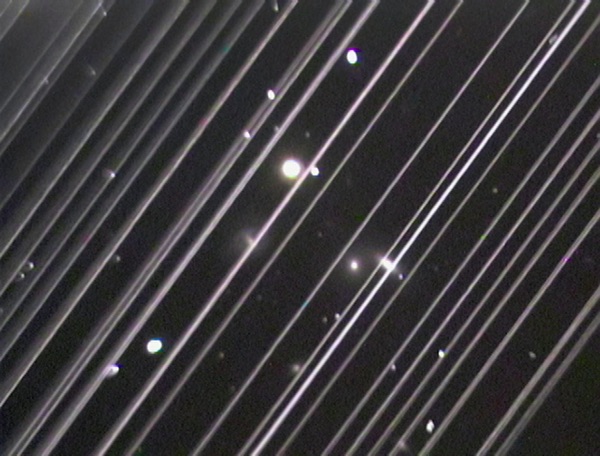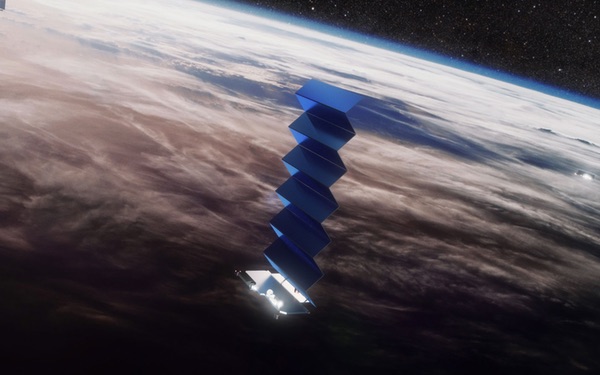Who speaks for the night sky?by A.J. Mackenzie
|
| To hear astronomers talk, the Starlink satellites and their kin would overwhelm natural objects in the night sky. |
For astronomers, however, that group of satellites was an ominous harbinger. That line of satellites is just the beginning of a constellation that, if fully built out, will reach about 12,000 satellites, several times the number of operational satellites in orbit today. Other constellations are in the works that will place anywhere from several hundred to several thousand satellites into low Earth orbit.
Many astronomers in the US spent the long holiday weekend that followed those initial Starlink spottings ruminating and worrying about the effect those satellites will have on their research. Some directed their vitriol at SpaceX and CEO Elon Musk.
“Musk & others who have their sights set on commercialization of space are selling us something the pros and cons of which have not been discussed,” tweeted noted planetary scientist Carolyn Porco. Many others shared similar views.
Astronomical observatories and organizations followed suit, like the International Astronomical Union. “The organisation, in general, embraces the principle of a dark and radio-quiet sky as not only essential to advancing our understanding of the Universe of which we are a part, but also as a resource for all humanity and for the protection of nocturnal wildlife,” it said in a statement last week. “We do not yet understand the impact of thousands of these visible satellites scattered across the night sky and despite their good intentions, these satellite constellations may threaten both.”
It seems clear that, yes, constellations like Starlink could adversely affect at least some professional astronomers. Even SpaceX acknowledges that: Musk noted in one tweet that he asked his engineers to look at ways to reduce the reflectivity in future Starlink satellites and thus their brightness in evening and morning skies.
But there are bigger issues at play. One is just how big of an effect Starlink and other satellites will have. Another is what role astronomers will have—and should have—in deciding whether satellites like that should fly.
To hear astronomers talk, the Starlink satellites and their kin would overwhelm natural objects in the night sky. Hundreds would be visible to the naked eye in the night sky at any time, they said, particularly at summertime in the high latitudes. Those moving objects would effectively wipe out the night sky, ruining it for future generations.
However, this case is built on histrionics and hyperbole. Take, for example, an anecdote from a statement by the International Dark Sky Association. A university professor was taking a student group out for some observing when the Starlink satellites passed by. Seeing them, he said, was a “shocking and devastating sight.”
Shocking? That seems reasonable, given their novel, unique appearance on the night sky. Devastating? Hardly. “Devastating” should be reserved for the effects of climate change or gun violence or other major calamities. Having a line of satellites speed across the sky is a minor annoyance, at best.
 An image of Starlink satellites passing through a field of view a few days after their launch. (credit: Victoria Girgis/Lowell Observatory) |
Both that statement and the one from the IAU included the same image: a time-lapse image of a region of the sky as the Starlink satellites passed by. The image showed them as parallel diagonal streaks, as if the Earth was being trapped within a Tholian web from Star Trek. But, the IAU statement noted that image was exaggerated; once the satellites are in the final, higher orbits, spaced out, they won’t have the same dramatic appearance. Indeed, in the two weeks since their launch, the satellites have become dimmer, and some say they’ve become hard to see without the use of binoculars, except for some occasional flares.
| Astronomer acted, in essence, as though it was their night sky that was being violated by these satellites, complaining that SpaceX hadn’t asked for their permission to launch them. |
And just how great of an impact will Starlink and related satellites have on astronomy? Maybe not as much as some feared. The Large Synoptic Survey Telescope (LSST) plans to start wide-field imaging of the sky in 2021, when Starlink and other constellations may have more than a thousand satellites in orbit. It would seem to be as vulnerable to Starlink as any observatory.
“A very conservative upper limit on the number of LSST pixels affected by Starlink satellites is about 0.01%, and quite likely smaller,” the observatory said in a statement last week. “Therefore, for LSST, even a constellation of about 10,000 Starlink satellites would be a nuisance rather than a real problem.”
That doesn’t exactly sound devastating.
There was another problem in astronomers’ reactions to Starlink. They acted, in essence, as though it was their night sky that was being violated by these satellites, complaining that SpaceX hadn’t asked for their permission to launch them. As Porco tweeted, “the pros and cons of [this] have not been discussed.”
But the pros and cons—most of them, at least—had been discussed for years. SpaceX has been talking about its satellite constellation for several years, not to mention other companies like OneWeb and Telesat. Were astronomers completely ignorant of these developments? Did not one of them wonder what such constellations might look like in the sky? If so, it shows a remarkable lack of knowledge and imagination.
Contrary to the belief of some, Starlink didn’t launch without discussion or permission. SpaceX had to get a launch license from the FAA and a communications license for its entire constellation from the FCC. The latter includes a public record, where companies and organizations can file comments. But, according to one news report, the only filing with the FCC by astronomers regarding Starlink came from radio astronomers, worried about radio frequency interference.
To be fair, even if they complained to the FCC, or the FAA, there may have been nothing those agencies could do. Nothing in their regulations, or federal law, says anything about the appearance of the night sky, beyond a prohibition on space advertising. Yet, filing comments might have prompted discussion between astronomers and SpaceX prior to the first satellite launch, and maybe a more constructive discussion and outcome than the heated rhetoric after last month’s launch.
| If astronomers are worried about human activity ruining the night sky, there’s far greater, and existing, threat than satellites. |
There is also a more fundamental question here that goes beyond federal laws and license applications comments. Astronomers have argued that having thousands of Starlink and other satellites would ruin the night sky. But would it? Would the average person—not the astronomer—notice these satellites? Would they care? Would they actually like to see them, just as stargazers have been entranced for years by Iridium flares?
If astronomers are worried about human activity ruining the night sky, there’s far greater, and existing, threat than satellites. Light pollution has, for decades, dimmed the skies in cities and suburbs, turning a sky filled with thousands of stars into one with only hundreds, or even dozens. (In such skies, it’s hard to even see the Starlink satellites; they’re just not bright enough to cut through the haze.)
Astronomers do speak out about it, but it’s usually only about how it affects their observatories in Arizona or Hawaii or Chile. If they really cared about the average person’s view of the night sky, they would do far more about light pollution than the current modest efforts of the International Dark Sky Association. Broader efforts to curb light pollution would do far more to preserve the constellations of the night sky than any effort to block a constellation of satellites.
If astronomers want to speak for the night sky, they need to do a better job.
Note: we are temporarily moderating all comments subcommitted to deal with a surge in spam.
